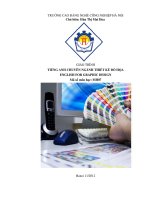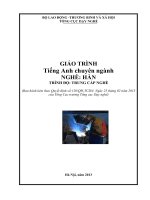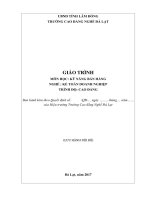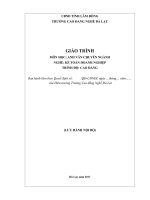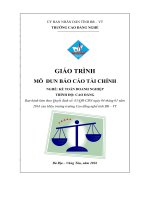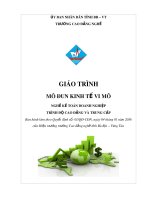Giáo trình Tiếng Anh chuyên ngành (Nghề Kế toán doanh nghiệp)
Bạn đang xem bản rút gọn của tài liệu. Xem và tải ngay bản đầy đủ của tài liệu tại đây (352.27 KB, 70 trang )
BỘ NÔNG NGHIỆP VÀ PHÁT TRIỂN NÔNG THÔN
TRƯỜNG CAO ĐẲNG CƠ GIỚI NINH BÌNH
GIÁO TRÌNH
MƠN HỌC: ANH VĂN CHUN NGÀNH
NGHỀ: KẾ TỐN DOANH NGHIỆP
TRÌNH ĐỘ: CAO ĐẲNG
Ban hành kèm theo Quyết định số:
/QĐ-TCGNB ngày…….tháng….năm .....
của trường Cao đẳng Cơ giới Ninh Bình
1
Ninh Bình
TUYÊN BỐ BẢN QUYỀN
Tài liệu này thuộc loại sách giáo trình nên các nguồn thơng tin có thể được
phép dùng nguyên bản hoặc trích dùng cho các mục đích về đào tạo và tham
khảo.
Mọi mục đích khác mang tính lệch lạc hoặc sử dụng với mục đích kinh
doanh thiếu lành mạnh sẽ bị nghiêm cấm.
2
LỜI GIỚI THIỆU
Ngoại ngữ nói chung và tiếng Anh nói riêng đang là môn học cấp thiết và
rất hữu dụng đối với sinh viên các khối nghề. Môn học này trang bị cho học viên
những kiến thức để thực hiện các kỹ năng giao tiếp cơ bản. Sử dụng tiếng Anh
nhằm tạo điều kiện cho học sinh có thể tiếp xúc với các nguồn tài liệu khác nhau
từ nhiều quốc gia. Bên cạnh đó, chiếm lĩnh kiến thức từ mơn học này sẽ thuận
lợi hơn khi xin việc tại các Cơng ty nước ngồi, Cơng ty liên doanh cũng như
các Cơng ty, các doanh nghiệp trong nước địi hỏi có trình độ về ngoại ngữ.
Nhằm đáp ứng yêu cầu về học tập, giảng dạy và nghiên cứu của học viên,
khoa Kinh tế - Du lịch trường Cao đẳng Cơ giới Ninh Bình đã tổ chức biên soạn
cuốn: “Tiếng Anh chuyên ngành Kế tốn doanh nghiệp ”. Giáo trình bước đầu
giúp học viên tiếp xúc với Tiếng Anh trong lĩnh vực kế tốn. Giáo trình sẽ tái
hiện lại các kiến thức giúp các em củng cố, luyện tập bốn kỹ năng: Nghe – Nói –
Đọc – Viết. Ngồi ra, sẽ cung cấp cho học viên một số vốn từ, thuật ngữ, mẫu
câu và những hiểu biết tập trung theo từng chủ đề. Qua đó, các em có thể dùng
tiếng Anh để giao tiếp trong một số tình huống cụ thể.
Lần đầu tiên cuốn giáo trình được biên soạn, chắc chắn không tránh được
thiếu sót. Chúng tôi mong muốn nhận được sự đóng góp của các đồng nghiệp,
độc giả và những người quan tâm để cuốn sách được chỉnh sửa, bổ sung ngày
càng hoàn thiện hơn.
Xin chân thành cảm ơn!
Ninh Bình, ngày…..........tháng…........... năm
Tham gia biên soạn
1. Chủ biên: Hoàng Xuân Hảo
2. Lê Thị Vân Nga
3. Nguyễn Thị Thu Nga
3
CHƯƠNG TRÌNH MƠN HỌC AVCN CĐKTDN
Tên mơn học: Anh văn chuyên ngành
Mã số môn học: MH 34
Thời gian thưc hiện môn học: 60 giờ; (Lý thuyết: 40 giờ; Thực hành, thảo
luận, bài tập: 18 giờ; Kiểm tra: 2 giờ)
I. Vị trí, tính chất của mơn học:
- Vị trí: Mơn học được bố trí giảng dạy sau khi đã học xong các mơn học
cơ sở.
- Tính chất: Là mơn học chun mơn nghề.
- Ý nghĩa va vai trị: Đây là mơn học dành cho sinh viên chuyên ngành k ế
toán, cung cấp cho học viên một số vốn từ, thuật ngữ, mẫu câu và những hiểu
biết tập trung theo từng chủ đề.
II. Mục tiêu môn học:
- Về kiến thức:
+ Sử dụng được những thuật ngữ chuyên ngành liên quan đến tài chính
và kế tốn;
+ Sử dụng một số cấu trúc ngữ pháp hay dùng trong tiếng Anh chuyên
ngành như: thể bị động, mệnh đề quan hệ, câu mong ước, câu điều kiện, tính từ
so sánh, liên từ, giới từ…
- Về kỹ năng:
Đọc, hiểu và dịch được một số tài liệu liên quan đến chun ngành tài
chính và kế tốn từ Tiếng Anh sang Tiếng Việt.
- Về năng lực tự chủ và trách nhiệm:
Người học có thái độ học tập nghiêm túc, cố gắng tiếp thu kiến thức hiệu
quả nhất để sau này vận dụng kiến thức đã học vào dịch tài liệu chuyên ngành
nhằm nâng cao chuyên môn trong công việc.
III. Nội dung môn học:
4
TABLE OF CONTENT
Unit 1: MARKET ECONOMY............................................................................7
1. Vocabulary.......................................................................................................7
2. Reading comprehension..................................................................................7
3. Language focus................................................................................................9
4. Writing in business........................................................................................11
Unit 2: MICROECONOMICS...........................................................................13
1. Vocabulary.....................................................................................................13
2. Reading comprehension................................................................................13
3. Word study.....................................................................................................14
4. Language focus..............................................................................................15
5. Writing in business........................................................................................16
Unit 3: MACROECONOMICS..........................................................................19
1. Vocabulary.....................................................................................................19
2. Reading comprehension................................................................................19
3. Word study.....................................................................................................21
4. Language focus..............................................................................................23
5. Writing in business........................................................................................24
Unit 4: SUPPLY AND DEMAND.......................................................................27
1. Vocabulary.....................................................................................................27
2. Reading comprehension................................................................................27
3. Word study.....................................................................................................31
4. Language focus..............................................................................................32
5. Writing in business........................................................................................33
Unit 5: MONEY AND ITS FUNCTION............................................................36
1. Vocabulary.....................................................................................................36
2. Reading comprehension................................................................................36
3. Word study.....................................................................................................38
4. Language focus..............................................................................................39
5. Writing in business........................................................................................39
Unit 6: ACCOUNTING.......................................................................................42
1. Vocabulary.....................................................................................................42
2. Reading comprehension................................................................................42
5
3. Word study.....................................................................................................45
4. Language focus..............................................................................................46
5. Writing in business........................................................................................47
Unit 7: STOCK EXCHANGE.............................................................................49
1. Vocabulary.....................................................................................................49
2. Reading comprehension................................................................................49
3. Word study.....................................................................................................50
4. Language focus..............................................................................................51
5. Writing in business........................................................................................52
Unit 8: STOCK EXCHANGE.............................................................................54
1. Vocabulary.....................................................................................................54
2. Reading comprehension................................................................................54
3. Word study.....................................................................................................56
4. Language focus..............................................................................................59
5. Writing in business........................................................................................59
Unit 9: STOCK EXCHANGE.............................................................................62
1. Vocabulary.....................................................................................................62
2. Reading comprehension................................................................................62
3. Word study.....................................................................................................65
4. Language focus..............................................................................................65
5. Writing in business........................................................................................67
6
unit 1. MARKET economY
Mã bài: AVCN 01
Giới thiệu: Bài học này giúp học viên tìm hiểu về khái niệm nền kinh tế.
Mục tiêu:
- Sử dụng được các thuật ngữ liên quan đến nền kinh tế, nền kinh tế thị
trường, nền kinh tế lập kế hoạch, thu nhập quốc nội;
- Đọc, hiểu và dịch được tài liệu liên quan đến nền kinh tế, nền kinh tế thị
trường, nền kinh tế kế hoạch, thu nhập quốc nội;
- Nghiêm túc, cùng hợp tác với giáo viên để hoàn thành bài học.
Nội dung chính:
I. Vocabulary
- afford (v); Đủ tiền, thời gian... để làm việc gì
- allowance (n); tiền tiêu, tiền trợ cấp
- seek (v); t×m kiÕm
- resources (n); nguån lùc
- scarce (adj); khan hiÕm
- merchandise (n); hàng hoá
- economy (n); nền kinh tế
- economics (n); kinh tÕ häc
- economist (n); nhµ kinh tÕ häc
- savings (n); tiỊn tiÕt kiƯm
- tax (n); th
- regulation (n); quy luật, luật lệ, điều lệ
- inflation (n); lạm phát
II. Reading comprehension
ECONOMICS
7
Most people want more than they can afford to buy. If families buy one
thing, they may not be able to afford something they would like. The same is
true of nations. Whether a nation is rich or poor, most of its people want more
than they can afford. They seek better schools, more houses and stronger armed
forces. The field of economics studies the way the thing people need and want is
made and brought to them. It also studies the way people and nations choose the
things they actually buy among the many things they want.
Economists (specialists in economics) define economics as the study of
how goods and services get produced and how they are distributed. By goods
and services, economists mean everything that can be brought and sold. By
produced, they mean the processing and making of goods and services. By
distributed, they mean goods and services are divided among the people.
In all countries, the resources used to produce goods and services are
scarce. That is, no nation has enough farms, factories and workers to produce
everything that everyone would like.
Money is also scarce. Few people have enough money to buy everything
they want when they want it. Therefore, people everywhere most choose the best
possible way to use their resources and money.
Children may have to choose whether to spend their allowances on a
motion picture or a Hamburger. Storekeepers may have to choose whether to
take a summer vacation or use their savings to buy more merchandise. A nation
may have to choose whether to use tax money to build more submarines. In
economic items, the children, the storekeepers, and the nation all must
economize in order to satisfy their most important needs and wants. This means
they must try to use the resources they have to produce the things they most
want.
Economics is a study of mankind. It tells us how man subsists, grows and
develops in relation to the wealth available on Earth. Relations made by persons
in the society which are in connection with material circumstances and
economic.
MARKET ECONOMY
An economic system in which the market – that is the relation between
producers and consumers, buyers and sellers, investors and workers,
8
management and labor – is supposed to be regulated by the law of suppy and
demand. Business firms are supposed to compete freely, and any attempt at
hindering free competition is punishable by law.
Direct government intervention is theoretically ruled out although the
government will influence the economic situation through its fiscal and
budgetary policies.
Answer the questions
1. Can people in most countries buy all the things they want?
……………………………………………………………………………
2. What do nations in the world want to do for their countries?
……………………………………………………………………………
3. What does the field of economics study?
……………………………………………………………………………
4. How do economists define economics?
……………………………………………………………………………
5. Are the resources in the world used to produce goods and services abundant?
……………………………………………………………………………
6. What do people and nations do with their limited resources and money?
……………………………………………………………………………
7. Why is it said that: Economics is a study of mankind?
……………………………………………………………………………
8. Which relations are called economic?
……………………………………………………………………………
9. What is market?
…………………………………………………………………………
10. What is market economy?
……………………………………………………………………………
III. Language focus:
9
Present simple and Present continuous
We use the present simple to:
∙ give factual information about company’s activities.
Hyundai has its headquarter in Seoul.
∙ talk about routine activities in the company.
I always check my e-mail in the morning.
We use the present continuous to:
∙ describe ongoings situations and projects.
We are constantly improving the way we sell our products.
∙ describe temporary situations.
She is staying in Paris till the end of the month.
∙ talk about future arrangements.
We are opening a new store next week.
1.
Complete the sentences with the present simple or present continuous form of the verbs in bracket.
a. We normally................ (hold) our sales conference in Spain, but
this year we ................(hold) it in Germany.
b. Although we ................(use) our own sales rep. at the moment,
we generally ................(use) agents in Japan.
c. It normally................(take) us two years to develop a new product.
d. We don’t often................(raise) our prices more than 5%, but
this time we................ (raise) them 10%.
e. Usually our Sales Director ................(deal) with important customers.
f. We usually................ (recruit) from within the company, but this
time we ................ (advertise) externally.
g. We................(rent) offices until our new headquarter are ready.
h. The company ................(want) to achieve record sales this year.
2.
Complete this job advertisement with the present simple or present
continuous form of the verbs in the box.
look
offer
Have
Prepare
Offer
Consider
10
employ
need
be
grow
SALES MANAGER
We.................. one of the largest mobile phone retailers in Europe.
We.................. independent and impartial advice on mobile phones.
We ..................more than 800 stores in 10 countries, and we..................
fast. We.................. over 3,000 workers. Currently we .................. the
next stage in our development, and we .................. for major growth outside Europe. We.................. for people who are reliable, confident and
enthusiastic. We .................. experienced people who want to work for an
expanding company. We .................. a competitive salary and private
health insurance. We are willing to reward staff with attractive performance-based bonuses.
Ring 020 7973 3864 for an information back
IV. Writing in business lf
1. Each sentence has a mistake. Underline and correct it
Correct
1. Let me to introduce to my colleague.
1……………….
2. Asia is one of the company’s major market.
2……………….
3. Nokia’s sales in China is very high.
3……………….
4. The Nokia N72 is a very successful production.
4……………….
5. Are there a conference room in the hotel?
5……………….
6. How far does it take you to get there? - 3 hours.
6……………….
7. The meeting starts in 10.15 A.M.
7……………….
11
8. There aren’t much suitable candidates for the job.
8………………
2. Make questions for the underlined words
1. Our company is looking for new markets.
…………………………………………………..
2. They usually hold the meetings in the conference room.
…………………………………………………..
3. That company employs 3.000 people within our country.
…………………………………………………..
4. The nearest international airport is about 2km from here.
…………………………………………………..
5. In this country, banks open at 8 o’clock.
…………………………………………………..
6. It took her three hours to fly to the south of the country.
…………………………………………………..
7. As there was no bus at midnight, he walked home.
…………………………………………………..
8. He works at a Japanese company.
…………………………………………………..
9. The company’s general director arrived here yesterday by his own
plane.
…………………………………………………..
10. This dish is made with chicken and onions.
…………………………………………………..
12
UNIT 2. MICROECONOMICS
Mã bài: AVCN 02
Giới thiệu: Bài học này giúp học viên tìm hiểu về khái niệm kinh tế vi mô.
Mục tiêu:
- Sử dụng được các thuật ngữ liên quan đến kinh tế vi và mô kinh tế vĩ
mô;
- Đọc, hiểu và dịch được các tài liệu liên quan đến kinh tế vi mô, kinh tế
vĩ mô;
- Nghiêm túc, cùng hợp tác với giáo viên để hoàn thành bài hc.
Ni dung chinh:
I. Vocabulary
- approach (n); tiếp cận, phơng pháp
- aggregate (v); tính gộp lại, tính hợp lại
- relative price (n); giá tơng đối
- general equilibrium theory (n); thuyết cân bằng tổng
thể
- interaction (n); tác động qua lại, ảnh hởng lÉn nhau
- theoretical (adj); thuéc vÒ lý thuyÕt
- competition (n); c¹nh tranh
II. Reading comprehension
Microeconomics is a branch of economics that analyzes
the market behavior of individual consumers and firms in an
attempt to understand the decision-making process of firms and
households. It is concerned with the interaction between
individual buyers and sellers and the factors that influence the
choices
made
by
buyers
and
13
sellers.
In
particular,
microeconomics focuses on patterns of supply and demand and
the determination of price and output in individual markets (e.g.
coffee industry).
Microeconomic
studies
individual
decisions
about
particular commodities, it examines how these decisions and
behaviors affect the supply and demand for goods and services,
which determines prices, and how prices, in turn, determine the
supply and demand of goods and services. For example, we
might study why individual households prefer cars to bicycles
and how producers decide whether to produce car or bicycles.
We can then aggregate the behavior of all the households and
all the firms to discuss total car purchases and total car
production.
The field of microeconomics known as general equilibrium
theory extends this approach to its logical conclusion. It studies
simultaneously every market for every commodity. From this, it
is hoped that we can understand the completed pattern of
consumption, production, and exchange in the whole economy
at a point in time.
Microeconomics also deals with the effects of national
economic policies (such as changing taxation levels) on the
before mentioned aspects of the economy.
One of the goals of microeconomics is to analyze market
mechanisms that establish relative prices amongst goods and
services and allocation of limited resources. Microeconomics
analyzes market failure, where markets fail to produce efficient
results, and describes the theoretical conditions needed for
perfect competition.
Answer the questions
1. Why does the microeconomics analyze the behavior of
individual firms and consumers?
……………………………………………………………………………
2. Does it focus on overall economic trends?
……………………………………………………………………………
14
3. What is needed before total car purchases and
production can be discussed?
……………………………………………………………………………
4. What is the field of microeconomics known as?
……………………………………………………………………………
III. Word study
Match the words and the definitions
word
definitions
- economist
- connect with money
- commodity
- combine different items, amounts
- interaction
- a state of balance
- monetary
- a product or a raw material that can be
- equilibrium
bought and sold
- aggregate
- influence each other
- a person who studies or writes about
economics
IV. Language focus
The past simple tense and The present perfect
tense
• We use the past simple tense:
- to talk about the completed actions that happened
in the past.
Example: They worked over last weekend to
meet the deadline.
- to refer a definite moment or period in the past.
Example: They made the presentation on
Monday.
15
• The present perfect connects the past and the present.
We use the present perfect:
- to talk about the past actions that affect us now.
Example: Our company has just introduced
flexitime and everyone’s
delighted.
- to talk about our life experiences.
Example: I’ve worked with many countries where
stress was a problem.
- to announced news.
Example: The CEO has appointed a new
management team.
A. Cross out the incorrect sentence in each pair.
1.
Stress levels have increased in recent years.
Stress levels increased in recent years.
2.
The role of woman changed dramatically over
the past 100 years.
The role of woman has changed dramatically
over the past 100 years.
3.
He has worked as a stress counsellor since 1999.
He worked as a stress counsellor since 1999.
4.
He resigned 2 months ago.
He has resigned 2 months ago.
5.
Have you ever been to a stress counsellor
before?
Did you ever go to a stress counsellor before?
6.
I have seen a stress counsellor last week.
I saw a stress counsellor last week.
16
B. Write the time expressions from the box under the
correct heading.
Past simple
so far
just
Presen perfect
two years ago
in 1999
yet
already
never
last
yesterday
for the last two weeks
Monday
ever
during the 1990s
over last few years
since 2001
when I was at university
V. Writing in business
1. Put the words in bracket into the correct forms
1. Sorry! I can’t go to your housewarming party next
Monday evening. I am having an (appoint)………………..
then.
2. What are the usual (work) ……………….. hours in your
company?
3. Hoan Kiem lake is one of Hanoi major tourist (attract)
………………...
4. The (fly) ……………….. to Ho Chi Minh city took me two
hours and a half last Tuesday.
5. Her dream is become a good (account) ………………...
6. Thank you for (invite) ……………….. us.
7. As a/an (nation) ……………….. language. English is
spoken widely by a very large number of people.
8. This company (product) ……………….. shoes to export.
17
2. Reorder the words to make meaningful sentences.
1. pass/ final exam/ she / easily / managed/ her / to/ .
…………………………………………………………………..
2. an / she / novelist / is / excellent / .
…………………………………………………………………..
3. cars / prefer / individual households / to bicycles / may /.
…………………………………………………………………..
4. always /easy / is / total car production / estimate / not / to / .
…………………………………………………………………..
5. bank / money / he/ to / went/ borrow / the / to.
…………………………………………………………………..
3. Read and complete the passage below using provided words.
rich
full
pair
hate
sons
on
interested
founder
likes
meeting
Phil Knight is the (1)……………. and CEO of Nike, a famous sports and
fitness company. He is from Oregon, USA. He is 65 and is very (2)………….
man. He is married, and his wife’s name is Penny. They have two (3)
……………. and one daughter. Knight loves sport, including tennis, running
and golf. He also (4)………….. fast cars. He says, “I love the fact that Nike is
about sports.” He has a tattoo of the Nike logo (5)………….. his left leg.
Knight’s ad agency is Wieden & Kennedy. At his first (6)
………………….. with Wieden, Knight said, “Hi, I’m Phil Knight. And I (7)
…………….. advertising.” But they are still partners after 21 years. At meetings
with Wieden, Knight is relaxed and tells jokes. He wears blue jeans, a T-shirt
and suit jacket, and a (8)…………….. of Nike shoes.
Knight is (9)………………. in Asia, especially Japan. His office is (10)
………….. of objects from Asia. It is in Nike’s World Headquarters in
Beaverton Oregon.
18
UNIT 3. MACROECONOMICS
Mã bài: AVCN 03
19
Giới thiệu: Bài học này giúp học viên tìm hiểu về khái niệm kinh tế vĩ mô.
Mục tiêu:
- Sử dụng được các thuật ngữ liên quan đến kinh tế vĩ mô, các câu bị
động;
- Đọc, hiểu và dịch được các tài liệu liên quan đến kinh tế vĩ mô;
- Nghiêm túc, cùng hợp tác với giáo viên để hoàn thành bài học.
Nội dung chính:
I. Vocabulary
- economic trend(n); xu híng kinh tế
- unemployment(n); tình trạng thất nghiệp
- balance of payment (n); bảng cân đối chi tiêu
- inflation (n); lạm phát
- monetary policy (n); chÝnh s¸ch tiỊn tƯ
- fiscal policy (n); chÝnh sách tài khoá, chính sách tài
chính
- revenue (n); thu nhập
- respond to (v); ph¶n øng
- taxation (n); thuÕ
- expenditure (n); chi tiªu, chi phÝ
II. Reading comprehension
Macroeconomics provides us with a bird’s eye view of country’s
economic landscape. Instead of looking at behavior of individual business and
consumer – called microeconomics – the goal of macroeconomics is to look at
overall economic trends such as employment levels, economic growth,
balance of payments, and inflation. The study of the world economy, for
example, is essentially a macroeconomics survey.
Just as a speed of an engine is regulated by its supply of fuel,
macroeconomics is influenced mainly by monetary policy, which controls a
nation’s money supply, and fiscal policy, which controls a government’s
20
revenue and spending. Control over an economy is essentially the hands of
each country’s central banks and government, because they control the money
that provides the fuel to keep the economy running.
Monetary policy, the control of nation’s money supply is managed by
each country’s central banks. Germany’s Bundesbank, Britain’s bank of
England, and the bank of Japan all regulate their supplies with basically the
same goals as the US Federal Reserve to promote economic growth and keep
inflation under control.
Just as a driver uses the accelerator to speed up or slow down a vehicle,
central bank controls the economy by decreasing the money supply. By carefully
regulating the supply money to fuel economic growth, a central bank works to
keep economy from overheating or slowing down too quickly.
Monetary policy is essentially a guessing game. There is no one statistic
to tell us how fact an economy is growing, and there is nothing that tells us how
quickly the economy will respond to changes that may take months or years to
implement. Central banks try to keep one eye to employment, resulting from
economic slow down.
The economy at large also can be controlled by regulating fiscal policy,
government revenue and spending. Although a country’s money supply is
controlled by central banks, government spending also greatly influenced by a
country’s economic growth. Just as a family’s economic health is influenced by
parents’ earning and spending habits, a nation’s economic heath is influenced by
government fiscal policies, such as taxation, spending and government
borrowing.
For better or for worse, the major economic influences in our daily lives,
such as inflation and unemployment, are primarily the result of macroeconomic
decisions.
Choose the best answer
1. Macroeconomics does not study:
a. the behavior of individual business and consumers.
b. overall economic trends such as employment levels, economic
growth, balance of payments and inflation.
21
c. the world economy.
d. interactions among economic factors in the whole economy.
2. Macroeconomics is influenced mainly by:
a. monetary policy
b. fiscal policy
c. open door policy.
d. a and b.
3. Which one is not an economic policy?
a. monetary policy
c. fiscal policy
b. insurance policy
d. open door policy.
4. The purpose of regulating the money supply by the central bank is
to:
a. keep inflation under control.
b. promote economic growth.
c. keep the economy from overheating or slowing down too
quickly.
d. all the answers above.
5. Fiscal policy deals with:
a. government revenue and spending
c. government borrowing
b. taxation.
d. all the answers above.
III. Word study
1. Match the words and the definitions
Word
1. monetary supply
2. balance of payment
Definitions
a. a general direction in which a situation is
changing or developing
b. the state of not having a job; the fact of a number
of people not having a job
c. the difference between the amount a country
pays for imports and the amount it receives for
exports in a particular period of time
22
3. unemployment
4. fiscal policy
5. inflation
6. trend
d. a general rise in the prices of goods and
services in a particular country, resulting in a fall
in the value of money
e. one of the main government policies that attempts
to influence the direction of the economy through
changes in government taxes, or through some
spending
f. the money that a government receives from taxes,
or that an organization, etc, receives from its
business
g. an amount of money spent
h. to react quickly or in the correct way to sth/ sb
7. taxation
8. revenue
i. the system of collecting money by taxes
j. the total amount of money that exists in the
economy of a country at a particular time
9. expenditure
10. respond to
1. _____
2. _____
3. _____
4. _____
5. _____
6. _____
7. _____
8. _____
9. _____
10. ____
2. Complete the following sentences using appropriate words or phrases in
bold from the reading text (not all words are used)
1. A rapid rise in prices is called……………..
2. Macroeconomics is the study of overall……………..
3. Increasing in real GNP are called……………..
4. Monetary policy should be contrasted with ……………..which refers
to government borrowing, spending and taxation.
23
5. Fiscal policy consists of …………….. and taxation.
IV. Language focus
The passive
The passive is formed by using the verb be and the past participle. For
example, the passive of present tense is formed with am/ is/ are + past
participle
We often use the passive form to focus on something that happens to
someone, when we do not want to focus on the person who does the action.
Example:
About 85% of the world rubber is produced in the Far East
We can use passive with a modal verb and expression like
have to
Example:
Stamps can be bought at any post office
Meals have to be prepared everyday
Exercise: Put the following into the passive voice
1. We can solve this problem.
……………………………………………………………………………
2. People should send their complaints to the head office.
……………………………………………………………………………
3. They have changed the date of the meeting.
……………………………………………………………………………
4. The government will influence the economic situation through its fiscal and
budgetary policies.
……………………………………………………………………………
5. In planned economies, governments fix production and consumption quotas
beforehand.
……………………………………………………………………………
6. Our supplier is shipping the goods next week.
……………………………………………………………………………
24
7. The government raised interest rates by 1%.
……………………………………………………………………………
8. He was asking me some difficult questions.
……………………………………………………………………………
9. The ABB gave a large order to us last year.
……………………………………………………………………………
10. David Gill from Marketing lent me this book.
……………………………………………………………………………
V. Writing in business
1. Each sentence has a mistake. Underline and correct it
Correct
1. Could you to bring me the menu, please?
……………...
2. My house is next the post office.
……………...
3. Sorry, I haven’t got some time to talk to you now.
……………...
4. Would you like playing chess with me?
……………...
5. The main competitor are Pizza Express and Ask.
……………...
6. She is in charge on organizing this meeting.
……………...
7. How about go to the English speaking club this weekend?
……………...
8. How is the conference yesterday?
……………...
9. He likes his job and he is good in it.
……………...
25



